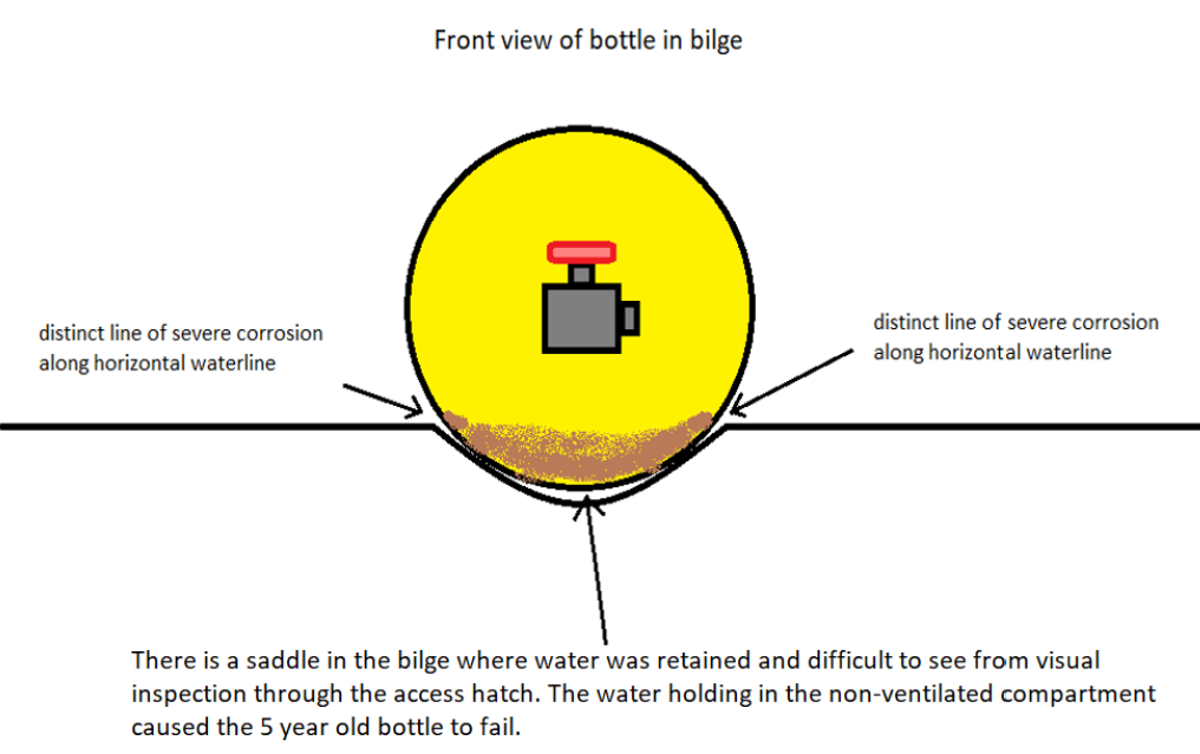Lifeboat air cylinder explosion on an empty installation
- Safety Flash
- Published on 29 August 2024
- Generated on 6 July 2025
- IMCA SF 17/24
- 3 minute read
Jump to:
An air bottle exploded on a lifeboat causing significant damage.
What happened?
An air bottle exploded on a lifeboat causing significant damage. The damage was discovered during a periodic inspection of an offshore platform which had been shut-in and had no crew on board. As the damage occurred on an uncrewed installation, there were no injuries or fatalities, but also no witnesses to the event or an exact date/time when it occurred.
The affected lifeboat was removed and taken ashore for further inspection. One of the bottles had exploded with a good portion of it propelling upward through the centreline seating structure and embedded itself into the overhead of the lifeboat. One bottle fell to the sea through the hole created in the hull of the boat and one bottle remained intact.
Why did it happen?
The operator coordinated with the lifeboat servicing vendor and local regulatory authorities to produce an understanding as to the probable cause of the incident. The following points were noted:
- The bottles in this boat were purchased new in 2018.
- Further inspection after the lifeboat was brought onshore revealed significant corrosion over the length of the bottles in the area where they were in contact with the bottom of the boat.
- Each of the three bottles was placed in a form fitting “saddle” built into the bottom structure of the lifeboat instead of being raised slightly above the deck in a cradle. The two brackets holding the bottles from above were made of stainless steel and there was no insulating material between this bracket and the steel bottles. It appears the installation and location of the bottles was subject to retaining moisture, especially between the bottle and the saddle. It could be that the corrosion was further exacerbated by galvanic action between the steel bottles and the uninsulated stainless-steel bracket.
Members should be aware that this could affect any lifeboat with steel air cylinders installed in the same manner.
Lessons learned
- The system ought to have been bled down after the platform was shut in and the crew taken off.
- This particular installation provided a very restricted access to these air bottles, so this greatly limited the ability to adequately inspect the bottles during regular weekly/monthly maintenance and annual servicing:
- The access ports only allowed a view of the top (valve end) of the bottle.
- The saddles in which the bottles rested completely obscured the section of the bottles inside the saddle.
- The bracket holding the bottles in place was of a different material and was in direct contact with the bottle (not insulated).
- The access ports only allowed a view of the top (valve end) of the bottle.

Actions
- Bleed down pressurised systems when no longer needed.
- Ensure pressurised air bottles are fully and adequately inspected during weekly/monthly maintenance and annual servicing.
- Look closely at the way in which pressurised air bottles are stored – could there be moisture traps? Is there a way to avoid that?
- Ensure pressurised air bottles in lifeboats are raised above the deck to provide better ventilation around the bottle.
- Ensure any device holding pressurised air bottles in place is a similar material or suitably insulated between materials that are dissimilar – be aware of the risk of galvanic corrosion.
Related Safety Flashes
-
IMCA SF
9 February 2023
-
IMCA SF 03/24
12 February 2024
-
IMCA SF 04/18
20 February 2018
-
IMCA Safety Flashes summarise key safety matters and incidents, allowing lessons to be more easily learnt for the benefit of the entire offshore industry.
The effectiveness of the IMCA Safety Flash system depends on the industry sharing information and so avoiding repeat incidents. Incidents are classified according to IOGP's Life Saving Rules.
All information is anonymised or sanitised, as appropriate, and warnings for graphic content included where possible.
IMCA makes every effort to ensure both the accuracy and reliability of the information shared, but is not be liable for any guidance and/or recommendation and/or statement herein contained.
The information contained in this document does not fulfil or replace any individual's or Member's legal, regulatory or other duties or obligations in respect of their operations. Individuals and Members remain solely responsible for the safe, lawful and proper conduct of their operations.
Share your safety incidents with IMCA online. Sign-up to receive Safety Flashes straight to your email.


